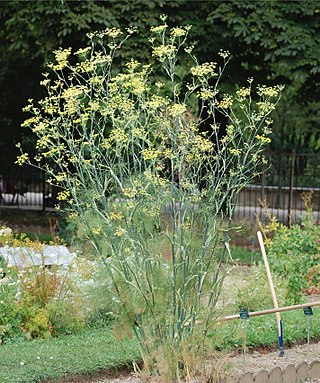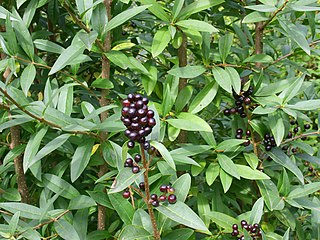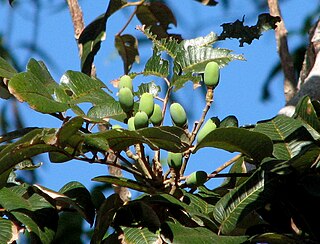
Oregano is a species of flowering plant in the mint family Lamiaceae. It was native to the Mediterranean region, but widely naturalised elsewhere in the temperate Northern Hemisphere.

Fennel is a flowering plant species in the carrot family. It is a hardy, perennial herb with yellow flowers and feathery leaves. It is indigenous to the shores of the Mediterranean but has become widely naturalized in many parts of the world, especially on dry soils near the sea coast and on riverbanks.

A privet is a flowering plant in the genus Ligustrum. The genus contains about 50 species of erect, deciduous or evergreen shrubs, sometimes forming small or medium-sized trees, native to Europe, north Africa, Asia, many introduced and naturalised in Australasia, where only one species, Ligustrum australianum, extends as a native into Queensland. Some species have become widely naturalized or invasive where introduced. Privet was originally the name for the European semi-evergreen shrub Ligustrum vulgare, and later also for the more reliably evergreen Ligustrum ovalifolium and its hybrid Ligustrum × ibolium used extensively for privacy hedging, though now the name is applied to all members of the genus. The generic name was applied by Pliny the Elder to L. vulgare. It is often suggested that the name privet is related to private, but the OED states that there is no evidence to support this.

Cirsium vulgare, the spear thistle, bull thistle, or common thistle, is a species of the Asteraceae genus Cirsium, native throughout most of Europe, Western Asia, and northwestern Africa. It is also naturalised in North America, Africa, and Australia and is an invasive weed in some areas. It is the national flower of Scotland.

Canarium is a genus of about 100 species of tropical and subtropical trees, in the family Burseraceae. They grow naturally across tropical Africa, south and southeast Asia, Indochina, Malesia, Australia and western Pacific Islands; including from southern Nigeria east to Madagascar, Mauritius, Sri Lanka and India; from Burma, Malaysia and Thailand through the Malay Peninsula and Vietnam to south China, Taiwan and the Philippines; through Borneo, Indonesia, Timor and New Guinea, through to the Solomon Islands, Vanuatu, New Caledonia, Fiji, Samoa, Tonga and Palau.

Canarium ovatum, the pili, is a species of tropical tree belonging to the genus Canarium. It is one of approximately 600 species in the family Burseraceae. C. ovatum are native to the Philippines. They are commercially cultivated in the Philippines for their edible nuts and is believed to be indigenous to that country. The fruit and tree are often vulgarized with the umbrella term of "Java almond" which mixes multiple species of the same genus, Canarium.

Canarium australianum is a species of trees, native to Australia and Papua New Guinea, of the plant family Burseraceae. Common names include mango bark, scrub turpentine, carrot wood, parsnip wood, Melville Island white beech and brown cudgerie.

Canarium asperum is a species of plant in the family Burseraceae. It is found in Brunei, Indonesia (Java), Malaysia, Papua New Guinea, the Philippines, and the Solomon Islands.

Laevistrombus canarium is a species of edible sea snail, a marine gastropod mollusc in the family Strombidae. Known from illustrations in books dating from the late 17th century, L. canarium is an Indo-Pacific species occurring from India and Sri Lanka to Melanesia, Australia and southern Japan. The shell of adult individuals is coloured from light yellowish-brown to golden to grey. It has a characteristic inflated body whorl, a flared, thick outer lip, and a shallow stromboid notch. The shell is valued as an ornament, and because it is heavy and compact, it is also often used as a sinker for fishing nets.

Oroxylum indicum is a species of flowering plant belonging to the monotypic genus Oroxylum and the family Bignoniaceae, and is commonly called Indian trumpet tree, oroxylum, Indian trumpet flower, broken bones, Indian caper, scythe tree or tree of Damocles. It can reach a height of 18 metres (59 ft). Various segments of the tree are used in traditional medicine, where it is known as Shyonaka or Sona Patha.
Proto-Malayo-Polynesian (PMP) is the reconstructed ancestor of the Malayo-Polynesian languages, which is by far the largest branch of the Austronesian language family. Proto-Malayo-Polynesian is ancestral to all Austronesian languages spoken outside Taiwan, as well as the Yami language on Taiwan's Orchid Island. The first systematic reconstruction of Proto-Austronesian ("Uraustronesisch") by Otto Dempwolff was based on evidence from languages outside of Taiwan, and was therefore actually the first reconstruction of what is now known as Proto-Malayo-Polynesian.

Eligma narcissus, the ailanthus defoliator, is a moth in the family Nolidae. The species was first described by Pieter Cramer in 1775. It is found in tropical Asia and the subtropics of China, India, Sri Lanka, Java and Southeast Islands.
Canarium acutifolium is a forest tree species, of the plant family Burseraceae, growing naturally in New Guinea, the Moluccas, Sulawesi, New Britain, New Ireland, Bougainville and in lowland north-eastern Queensland, Australia.
Canarium vitiense is a rainforest tree species, of the plant family Burseraceae, growing naturally in Fiji, the Solomon Islands, Samoa, Tonga, New Guinea, Bismarck Archipelago, Admiralty Islands, Louisiade Archipelago, Torres Strait Islands and in lowland north-eastern Queensland, Australia.

Kilu Cave is a paleoanthropological site located on Buka Island in the Autonomous Region of Bougainville, Papua New Guinea. Kilu Cave is located at the base of a limestone cliff, 65 m (213 ft) from the modern coastline. With evidence for human occupation dating back to 30,000 years, Kilu Cave is the earliest known site for human occupation in the Solomon Islands archipelago. The site is the oldest proof of paleolithic people navigating the open ocean i.e. navigating without land in sight. To travel from Nissan island to Buka requires crossing of at least 60 kilometers of open sea. The presence of paleolithic people at Buka therefore is at the same time evidence for the oldest and the longest paleolithic sea travel known so far.
Canarium commune is a repeatedly synonymized species name and may refer to one of several species in the tree genus Canarium:

Canarium indicum, known as galip nut, is a mainly dioecious tree native in eastern Melanesia. It is usually found in rainforests, secondary forests, old garden areas, around villages and settlements. It is also used as a shade tree, as a windbreak and in agroforestry. Canarium is important in the world food system as it can be used as a food and timber source, in traditional medicine, intercropping and agroforestry.
Arixyleborus malayensis, is a species of weevil found in India, Sri Lanka, China, Japan, Malaysia, Vietnam and Indonesia. This is the only species of Arixyleborus found in Japan and China.












